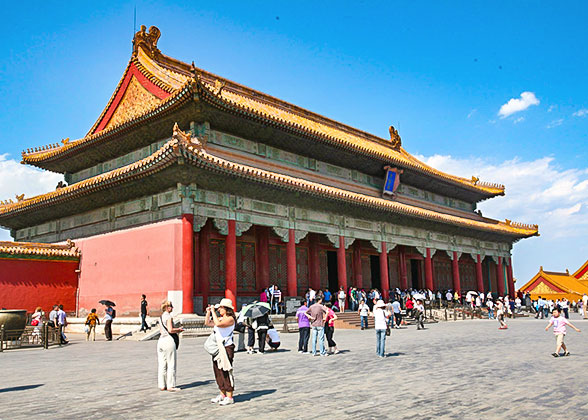The Hall of Preserved Harmony stands at the northern end of the three-tier marble terrace. Similar in style but somewhat smaller than the Hall of Supreme Harmony, it is larger than the Hall of Central Harmony. It was built in 1420, rebuilt in 1625 and renovated in 1765. The Ming Emperors would usually change into their ritual garments here prior to the ceremonial installation of an empress or crown prince. While during the Qing dynasty, the Hall of Preserved Harmony was usual for imperial banquets to be held here. Such banquets might be to celebrate a princess's marriage. The emperor would entertain high officials, the bridegroom and his father together with their relatives who served the imperial government. Each year, on the eve of the New Year's Eve, banquets would be held to feast and honour provincial governors, Mongol princes, civil and military officials.
 |
Hall of Preserved Harmony  Photos Photos |
 |
| Inside the Hall of Preserved Harmony |
In 1789, the midpoint of the Qing dynasty, Emperor Qianlong decided the final stage of the Palace Examination should be transferred from the Hall of Supreme Harmony to the Hall of Preserved Harmony. This was the highest level of the nation-wide imperial examination system and the emperor would honour the top ten successful candidates by reading the papers they had submitted.
On rainy days, visitors will have a chance to enjoy the spectacular sight of a thousand dragons disgorging water. There are 1,412 marble dragon heads below the columns of the three-tier terrace on which the three main halls stand. Chinese artisans cleverly combined the drainage system with these
architectural features. Once you get a chance to actually visit the Forbidden City, please note the spouts in the dragons' mouths. However, you will see that those on the corners have no spouts.
Huge Stone Carving
 |
| Huge Stone Carving |
Behind the Hall of Preserved Harmony, in the centre of the stairway, is a huge marble relief of nine dragons playing with pearls. It is the largest stone sculpture in the Forbidden City. Sculpted originally in the Ming dynasty, it was re-sculpted in the Qing dynasty. During these dynasties, anyone who was caught touching this holy stone would receive the death penalty! Weighing about 250 tons, the marble slab is 16.57 meters long, 3.07 meters wide and 1.7 meters thick. The huge stone was hauled into the palace all the way from Fangshan, up to 70 kilometers from Beijing. This difficult task took about a month employing twenty thousand men and thousands of mules and horses. It is said that a well was dug every 500 meters along the way and the well water was poured on the ground so as to form an icy road which could facilitate land boat transportation.

Next: Here tourists have three choices:

Continue to tour along the central axis: go north across the Qianqingmen Square to see the
Gate of Heavenly Purity (Qianqingmen), the entrance to the Inner Court.

Go east through the Gate of Great Fortune (Jingyunmen) to see the
Hall for Ancestry Worship (Fengxiandian), which houses the Clock and Watch Gallery. If time permits, one can explore further east to the
Palace of Tranquil Longevity (Ningshougong), a large building complex where the
Treasure Gallery is located.

Go west through the Gate of Great Ancestors (Longzongmen) to explore the
Palace of Compassion and Tranquility (Cininggong).

Further Reading:
How to visit the Forbidden City
- Last updated on Apr. 07, 2025 by Gabby Li -


